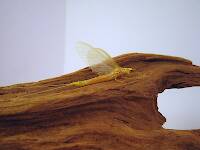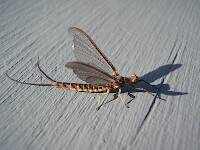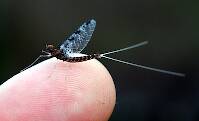
Hex Mayflies
Hexagenia limbata
The famous nocturnal Hex hatch of the Midwest (and a few other lucky locations) stirs to the surface mythically large brown trout that only touch streamers for the rest of the year.
Featured on the forum

I was not fishing, but happened to be at an unrelated social event on a hill above this tiny creek (which I never even saw) when this stonefly flew by me. I assume it came from there. Some key characteristics are tricky to follow, but process of elimination ultimately led me to Sweltsa borealis. It is reassuringly similar to this specimen posted by Bob Newell years ago. It is also so strikingly similar to this nymph from the same river system that I'm comfortable identifying that nymph from this adult. I was especially pleased with the closeup photo of four mites parasitizing this one.

Troutnut is a project started in 2003 by salmonid ecologist Jason "Troutnut" Neuswanger to help anglers and
fly tyers unabashedly embrace the entomological side of the sport. Learn more about Troutnut or
support the project for an enhanced experience here.
Konchu on Apr 29, 2007April 29th, 2007, 4:09 pm EDT
What might eliminate the spinner state? Hmmmm...
Perhaps some efficient predator eats the winged stages. Those individuals that released eggs the soonest would be selected "for." This is because those that tend to deposit eggs later in life never make it that far and are selected "against." Those that live reproduce and pass on their genes.
Perhaps some efficient predator eats the winged stages. Those individuals that released eggs the soonest would be selected "for." This is because those that tend to deposit eggs later in life never make it that far and are selected "against." Those that live reproduce and pass on their genes.
Quillgordon on Apr 30, 2007April 30th, 2007, 1:10 am EDT
Perhaps some efficient predator eats the winged stages. Those individuals that released eggs the soonest would be selected "for." This is because those that tend to deposit eggs later in life never make it that far and are selected "against." Those that live reproduce and pass on their genes.
At the present(correct me if I'm wrong), the sexual organs are not fully developed until the last molt or spinner stage. So the above senerio would still occur in the imago state not the subimago state.
What I meant was ...... could there be 'selection processes' that cause the subimago to emerge as a fully developed adult that could mate ( in a short amount of time), so it would not have to further molt into what we see as a spinner?
I guess I'm trying to make an analogy to caddis flies! They emerge as fully developed adults capable of mating.
Flyfishing is a state of mind! .............. Q.g.
C/R........barbless
C/R........barbless
Troutnut on Apr 30, 2007April 30th, 2007, 2:46 am EDT
At the present(correct me if I'm wrong), the sexual organs are not fully developed until the last molt or spinner stage.
I'm not sure if that's true. The organs certainly aren't in their final form in the dun stage, but maybe they're fully developed and just compressed within the dun's packaging until the molt. I know that's the case with the long fore legs of male spinners, but I don't know about the reproductive organs. Maybe one of the real entomologists can answer that one.
In other words, I'm not sure if there's actual growth/development during the dun stage, or if everything is grown in the nymph and just waiting to be used.
The reproductive organs aren't the only reason for mayflies to turn into spinners before trying to mate, though. Spinners have several other useful adaptations, like the longer legs on the males, which are handy for grasping the females mid-flight. Spinners are also much better at flying than duns, which makes them harder to catch, which is good because they spend so much more time in the air than duns. It's also useful because they have to maneuver to link up with mates. I wouldn't be surprised if their eyesight is better, too.
What I meant was ...... could there be 'selection processes' that cause the subimago to emerge as a fully developed adult that could mate ( in a short amount of time), so it would not have to further molt into what we see as a spinner?
Yes, there could! Females in the Ephoron genus ("White Flies") mate and die as duns.
Jason Neuswanger, Ph.D.
Troutnut and salmonid ecologist
Troutnut and salmonid ecologist
Quillgordon on Apr 30, 2007April 30th, 2007, 10:00 am EDT
Jason,
When I said the males are not fully developed , I was basing it on this:
I like the fact that mayflies are unique. I don't think we will see any further change in our lifetime!
John....
When I said the males are not fully developed , I was basing it on this:
Although all female mayflies are evidently sexually mature
as subimagos and male subimagos possess mature gametes, males evidently
are never reproductively mature as subimagos, i.e. male subimagos cannot
mate. We have never found fully formed male genitalia, including the femaleclasping
forceps, in subimagos of any species. The male genitalia grow in a
paurometabolous fashion rather than being prepackaged like legs and wings,
and this may be a major factor in restricting mating to male adults.
The fact that adult properties have not been incorporated into the male
subimago so that the final molt might be eliminated may be due to some
incompatability of the hydrofuge function with possible emergence function
and the mate-capturing and copulating function. If such incompatibility exists
we cannot account for it, particularly in view of some other aquatic insects
that combine the roles in the ultimate instar. We must continue to assume that
two molts from the larval stage are required for males to attain reproductive
maturity and function. Thus the subimago has at least some necessary role in
transformation.
I like the fact that mayflies are unique. I don't think we will see any further change in our lifetime!
John....
Flyfishing is a state of mind! .............. Q.g.
C/R........barbless
C/R........barbless
Troutnut on May 2, 2007May 2nd, 2007, 10:45 am EDT
Good work! You've got the answer, then. I knew about the legs and wings being prepackaged, but didn't realize the important parts are still growing in the dun.
Jason Neuswanger, Ph.D.
Troutnut and salmonid ecologist
Troutnut and salmonid ecologist
Quillgordon on May 2, 2007May 2nd, 2007, 12:33 pm EDT
Jason,
Maybe this would be a good subject for a paper by someone getting a degree in 'Entomology'.
Cheers.....
Maybe this would be a good subject for a paper by someone getting a degree in 'Entomology'.
Cheers.....
Flyfishing is a state of mind! .............. Q.g.
C/R........barbless
C/R........barbless
Quick Reply
Related Discussions
Topic
Replies
Last Reply
8
Jan 7, 2009
by Dgracia
by Dgracia
1
Sep 9, 2008
by GONZO
by GONZO






